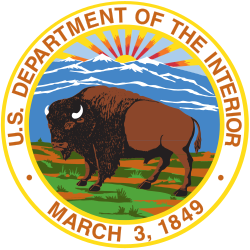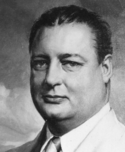Julius Albert Krug

Julius Albert Krug (* 23. November 1907 in Madison, Wisconsin; † 26. März 1970 in Knoxville, Tennessee) war ein US-amerikanischer Wirtschaftsmanager, Politiker und Innenminister.
Leben
Nach Beendigung der Madison Central High School studierte er von 1925 bis 1929 an der University of Wisconsin und schloss dieses Studium mit einem Bachelor of Arts (B.A.) ab. Ein anschließendes Postgraduiertenstudium an der University of Wisconsin beendete er 1930 mit einem Master of Arts (M.A.).
Nach Tätigkeiten bei der Tennessee Valley Authority (TVA) und als Stellvertretender Vorsitzender der Behörde für Kriegsproduktion (War Production Board) von 1943 bis 1944 leistete er zwischen 1944 und 1945 seinen Militärdienst bei der US Navy. Zugleich war er von 1944 bis 1945 Vorsitzender des War Production Board.
Am 18. März 1946 wurde er von US-Präsident Harry S. Truman zum Innenminister (US Secretary of the Interior) in dessen Kabinett berufen. Diesem gehörte er bis zum 1. Dezember 1949 an.
Später war er als Manager in der Privatwirtschaft tätig. Nach seinem Tod wurde er auf dem Nationalfriedhof Arlington beigesetzt.
Weblinks
- Julius Albert Krug in der Notable Names Database (englisch)
- Zeitungsartikel über Julius Albert Krug in den Historischen Pressearchiven der ZBW
- Julius A. Krug im Munzinger-Archiv (Artikelanfang frei abrufbar)
- Julius Albert Krug im Miller Center of Public Affairs der University of Virginia (englisch)
| Personendaten | |
|---|---|
| NAME | Krug, Julius Albert |
| KURZBESCHREIBUNG | US-amerikanischer Wirtschaftsmanager, Politiker und Innenminister |
| GEBURTSDATUM | 23. November 1907 |
| GEBURTSORT | Madison, Wisconsin |
| STERBEDATUM | 26. März 1970 |
| STERBEORT | Knoxville, Tennessee |
Auf dieser Seite verwendete Medien
Seal of the United States Department of the Interior.
The seal consists of a male bison with the head and body in a left position, standing on a prairie, with mountains and a rising sun in the background, enclosed within two concentric circles, having the words "U.S. Department of the Interior" and the date "March 3, 1849" (when Congress created the department) inscribed in the top and bottom arcs within these circles. See here for more information.
The bison seal dates from 1917, when it was used as the emblem on the initial department flag and thereafter replaced the old version of the seal, which used a federal eagle. The eagle was reinstated for a few years in the 1920s, and a different seal was used from 1968-69, but on both occasions the bison seal was reinstated. For more information see this chapter in The Department of Everything Else: Highlights of Interior History.

